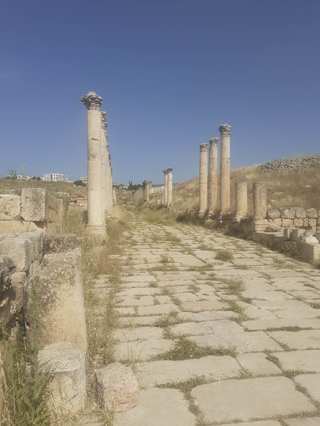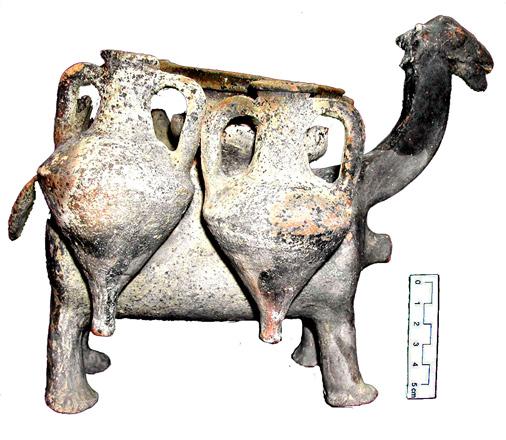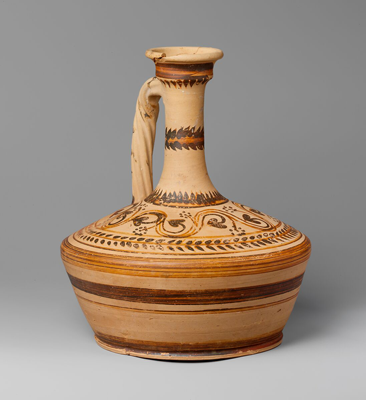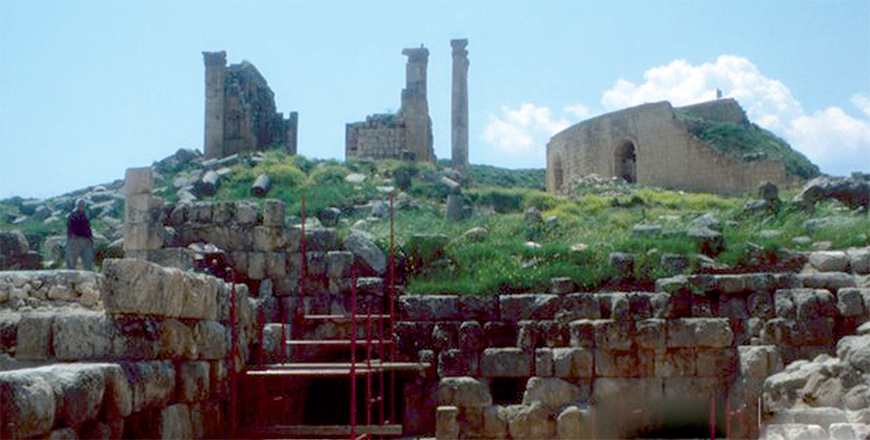You are here
Archaeologists unearth ancient tomb in Jordan shedding light on Ptolemaic cultural influence
By Saeb Rawashdeh - Nov 06,2023 - Last updated at Nov 06,2023

A colonnaded road in ancient Gerasa which was one of major pottery production centre in the southern Levant (Photo courtesy of Saeb Rawashdeh)
AMMAN — A group of archaeologist discovered a hypogean (underground) tomb in 2001 underneath the rocky foundations of the early 2nd-century AD Gerasacity wall. The burial objects found with the skeleton in the rock cut chamber of the tomb fit the material culture of the Late Hellenistic Levant.
“The position of each object in the chamber was plotted at the time of excavation. The Late Hellenistic pottery in the homogeneous fill of the dromos and the contemporary ceramic, metal and glass objects in the single chamber place the burial within the latter half of the 2nd century BC, at the very latest at the end of the century,” Ina Kehrberg-Ostrasz, a former professor of The University of Sydney, said.
According to Kehrberg-Ostrasz, who researched ancient Gerasa for decades, the deceased was a child, and some of the burial gifts — the glass astragals and glass counters, three pottery camel models, and a pottery model of a clepsydra worn smooth by frequent handling — had once been toys.
“The gold pectoral, iron strigil, bronze fibula, pottery rhyton, bull vase and lagynos are additional and fitting accoutrements for an internment of this period. A coin of Demetrius I completes the grave-goods, and corroborates a burial date in the second half of the 2nd century BC,” Kehrberg-Ostrasz said.
The ancient historian Flavius Josephus (37AD-100AD)praised Gerasa’s urban life and wealth of its citizens.
Furthermore, two burial gifts — the lagynos (a special type of ceramic vessel) and a pottery bull model dressed for sacrifice — are interesting because they recall descriptions of Ptolemaic festivals in Athenaeus’ Deipnosophists: Namely “eating-drinking banquets”, the “feast of pitchers”, and the “flagon-bearing” symposium, which is referred to in modern literature by the original Greek term lagynophoria, Kehrberg-Ostrasz elaborated.
“The association of Dionysiac festivals and their symposia with funerary rituals and banquets is no longer disputed by Classical scholars; such rituals may have been practiced by the Hellenised Alexandrians and subsequently by other communities too, once the lagynophoria, introduced in Egypt by Ptolemy II, spread further afield,” Kehrberg-Ostrasz noted, adding that bulls and other animals were sacrificed at the Dionysiac and Ptolemaic festivals.
Since the bull model carries a taenia and decorated horns like the bulls shown on Hellenistic and early Roman reliefs depicting sacrificial scenes, one may safely conclude that the model replicates a victim adorned for sacrifice.
“A lesser-known feature of this interment is what appears to be a simulated sacrificial ritual, in which one severed hind leg of the animal [in our case that of the pottery bull] had been placed in the dromos at the closure of the tomb. This apparently simulated practice at Gerasa may perhaps reveal Egyptian influence in the procedure of sacrifice during the funerary ritual before the banquet was held,” Kehrberg-Ostraszunderlined.
Furthermore, one may suggest from the presence of the lagynos and model bull in the Gerasa tomb that the Ptolemaic symposium existed in the form of a funerary banquet and that the lagynophoria festival itself was not unknown in Hellenistic Gerasa.
The area of modern Kordan was once part of geographical territory ruled by Ptolemies in the 3rd century BC.
However, material evidence of Ptolemaic cultural influence in Jordan is limited and has thus far been attested only by its architecture: Notably by the bestknown example of the Alexandrian school, i.e. the palatial residence “Qasr Al Abd” in the domain of Hyrcanus at Iraq Al Amir, the scholar pointed out.
“The restored 2nd-century ruins still give credence to the description of the princely domain in Josephus’ account of the fortunes and misfortunes of the Tobiads who were once in the service of the Ptolemies as tax collectors, and of the premature end of Hyrcanus under the Seleucids,” Kehrberg-Ostrasz underlined, adding it may be possible to identify evidence for the spread of Ptolemaic influence in Jordan.
Related Articles
AMMAN — Archaeologist Ina Kehrberg-Ostrasz has recently delved into the findings of an excavation of a small tomb containing the single buri
AMMAN — The Hellenistic period stretching from 323BC to roughly 30BC, between the death of Alexander the Great and the rise of the Rom
AMMAN — When the Roman Emperor Hadrian visited Gerasa (ancient Jerash) in 129/130 AD, the Roman Empire was at its peak.



















